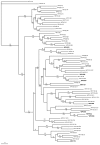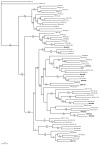Identification and characterization of eleven novel human gamma-papillomavirus isolates from healthy skin, found at low frequency in a normal population
- PMID: 24155922
- PMCID: PMC3796542
- DOI: 10.1371/journal.pone.0077116
Identification and characterization of eleven novel human gamma-papillomavirus isolates from healthy skin, found at low frequency in a normal population
Erratum in
- PLoS One. 2013;8(12). doi:10.1371/annotation/974c14e0-9cd1-4600-8259-abdc7927a318
- PLoS One. 2014;9(1). doi:10.1371/annotation/fa94362e-5639-42d9-b17b-f89c51c4e9bb
Abstract
Eleven novel human papillomavirus (HPV) types were isolated and characterized from healthy individuals in China. HPV163 belongs to the γ-1 species, HPV 164 and HPV 168 fit in the γ-8 species, HPV 165 and KC5 belongs to the γ-12 species, HPV 168 is closely allied with the γ-4 species, HPV 169 is closely related to the γ-11 species, and HPV 170 is related to the γ-12 species. In addition, HPV 161, HPV 162, and HPV 166 may form a new HPV species of the γ-PV genus. The prevalence of these HPV types in the normal population is low.
Conflict of interest statement
Figures


Similar articles
-
Characterization of novel human papillomavirus types 157, 158 and 205 from healthy skin and recombination analysis in genus γ-Papillomavirus.Infect Genet Evol. 2016 Aug;42:20-9. doi: 10.1016/j.meegid.2016.04.018. Epub 2016 Apr 21. Infect Genet Evol. 2016. PMID: 27108808
-
Metagenomic Discovery of 83 New Human Papillomavirus Types in Patients with Immunodeficiency.mSphere. 2018 Dec 12;3(6):e00645-18. doi: 10.1128/mSphereDirect.00645-18. mSphere. 2018. PMID: 30541782 Free PMC article.
-
Genomic and phylogenetic characterization of ChPV2, a novel goat PV closely related to the Xi-PV1 species infecting bovines.Virol J. 2020 Oct 30;17(1):167. doi: 10.1186/s12985-020-01440-9. Virol J. 2020. PMID: 33126890 Free PMC article.
-
Molecular methods for identification and characterization of novel papillomaviruses.Clin Microbiol Infect. 2015 Sep;21(9):808-16. doi: 10.1016/j.cmi.2015.05.011. Epub 2015 May 21. Clin Microbiol Infect. 2015. PMID: 26003284 Review.
-
Genome variation of human papillomavirus types: phylogenetic and medical implications.Int J Cancer. 2006 Mar 1;118(5):1071-6. doi: 10.1002/ijc.21655. Int J Cancer. 2006. PMID: 16331617 Review.
Cited by
-
HPV Infections-Classification, Pathogenesis, and Potential New Therapies.Int J Mol Sci. 2024 Jul 11;25(14):7616. doi: 10.3390/ijms25147616. Int J Mol Sci. 2024. PMID: 39062859 Free PMC article. Review.
-
A systematic approach to novel virus discovery in emerging infectious disease outbreaks.J Mol Diagn. 2015 May;17(3):230-41. doi: 10.1016/j.jmoldx.2014.12.002. Epub 2015 Mar 4. J Mol Diagn. 2015. PMID: 25746799 Free PMC article. Review.
-
A retrospective investigation on canine papillomavirus 1 (CPV1) in oral oncogenesis reveals dogs are not a suitable animal model for high-risk HPV-induced oral cancer.PLoS One. 2014 Nov 17;9(11):e112833. doi: 10.1371/journal.pone.0112833. eCollection 2014. PLoS One. 2014. PMID: 25401953 Free PMC article.
-
Improvements to pairwise sequence comparison (PASC): a genome-based web tool for virus classification.Arch Virol. 2014 Dec;159(12):3293-304. doi: 10.1007/s00705-014-2197-x. Epub 2014 Aug 14. Arch Virol. 2014. PMID: 25119676 Free PMC article.
-
Viral Metagenomics Reveals a Putative Novel HPV Type in Anogenital Wart Tissues.Pathogens. 2022 Dec 1;11(12):1452. doi: 10.3390/pathogens11121452. Pathogens. 2022. PMID: 36558785 Free PMC article.
References
Publication types
MeSH terms
Associated data
- Actions
- Actions
- Actions
- Actions
- Actions
- Actions
- Actions
- Actions
- Actions
- Actions
- Actions
Grants and funding
LinkOut - more resources
Full Text Sources
Other Literature Sources

